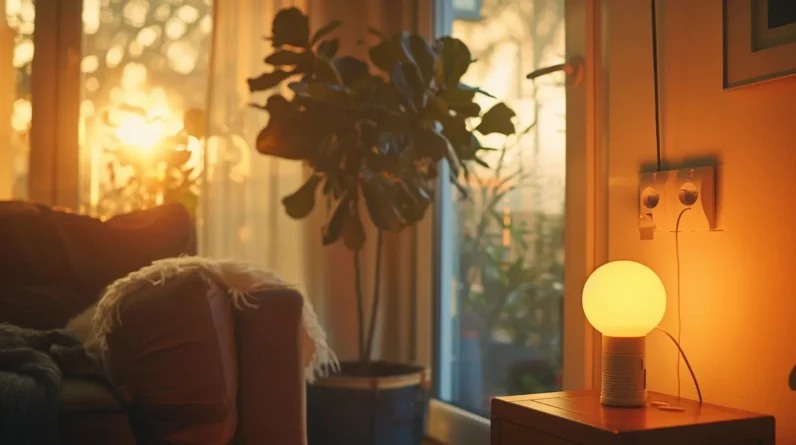
In our smart homes, optimizing smart thermostats, choosing energy-efficient security devices, and utilizing smart lighting solutions can substantially enhance both security and energy savings. Implementing smart power strips and leveraging window treatments further reduce unnecessary power consumption. Regular maintenance and updates of our smart devices guarantee they operate at peak efficiency. There’s more to explore for a truly energy-efficient smart home.
Optimize Your Smart Thermostat Settings
To optimize your smart thermostat settings, we need to understand how it works. Smart thermostats learn from our behaviors and adjust temperatures accordingly. By properly calibrating your thermostat, you can guarantee accurate temperature readings and efficient heating/cooling. Set a schedule that aligns with your daily routine, allowing the thermostat to automatically adjust temperatures when you’re away or sleeping. Utilize temperature zoning to customize settings for different areas of your home, prioritizing comfort where you need it most and saving energy in unused spaces. Regularly review your energy usage reports to identify opportunities for further optimization and savings. With the right settings and features, your smart thermostat can help reduce energy waste and lower utility bills without sacrificing comfort.
Choose Energy-Efficient Security Devices
Beyond optimizing your smart thermostat, we should also focus on selecting energy-efficient security devices for our homes. When it comes to device selection, look for products with the Energy Star label, indicating they meet strict energy efficiency guidelines set by the EPA. We can further reduce energy consumption by choosing devices with built-in motion sensors, which activate only when needed. During device installation, place sensors and cameras strategically to maximize coverage while minimizing the number of devices required. By carefully selecting and installing energy-efficient security devices, we can protect our homes while keeping our energy usage in check.
Utilize Smart Lighting Solutions
As we explore ways to make our smart homes more energy-efficient, let’s not overlook the importance of utilizing smart lighting solutions. By incorporating motion sensors and dimmer switches, we can substantially reduce our energy consumption. Motion sensors guarantee that lights are only activated when needed, preventing unnecessary energy waste. Dimmer switches allow us to adjust the brightness of our lights, reducing energy usage when full illumination isn’t required. These smart lighting solutions not only contribute to a more sustainable home but also provide added convenience and customization options. Let’s embrace these technologies to create a smarter, greener living environment.
Implement Smart Power Strips
Many of our electronic devices continue to draw power even when they’re turned off, a phenomenon known as “vampire energy.” To combat this, we can implement smart power strips in our homes. These power strips are designed to cut off power to devices that aren’t in use, reducing unnecessary energy consumption. By connecting our devices to smart outlets or power strips, we can control them remotely or set schedules for when they should be turned on or off. This not only saves energy but also extends the lifespan of our devices. With smart power strips, we can optimize our energy usage and reduce our carbon footprint without sacrificing convenience or security.
Leverage Smart Window Treatments
Smart window treatments offer a sophisticated way to manage natural light and heat in our homes. By installing automatic shades or motorized blinds, we can optimize our energy consumption. These devices can be programmed to adjust based on the time of day, season, or even the amount of sunlight. In summer, they can close to block out the sun, reducing the need for air conditioning. In winter, they can open to allow the sun’s warmth, decreasing heating costs. Additionally, some smart window treatments come with sensors that automatically adjust based on the room’s temperature, ensuring ideal energy efficiency without manual intervention.
Regularly Maintain and Update Your Devices
While we often focus on the installation of smart devices, it’s equally important to regularly maintain and update them to guarantee superior performance and energy efficiency. Firmware and software updates can substantially enhance device functionality, fix bugs, and improve battery life. By staying current with updates, we guarantee our smart security systems operate at peak efficiency, minimizing energy consumption. Regular maintenance, such as cleaning sensors and replacing batteries, also prevents false alarms and unnecessary power drain. Taking a proactive approach to device updates and maintenance not only extends the life of our equipment but also optimizes our smart home’s energy usage.
Conclusion
By optimizing our smart thermostats, choosing energy-efficient devices, utilizing smart lighting, implementing smart power strips, leveraging smart window treatments, and maintaining our devices, we can substantially reduce our energy consumption. In fact, studies show that smart thermostats alone can save up to 23% on annual heating and cooling costs. Let’s embrace these energy-saving tips to create a more efficient and secure smart home environment.







